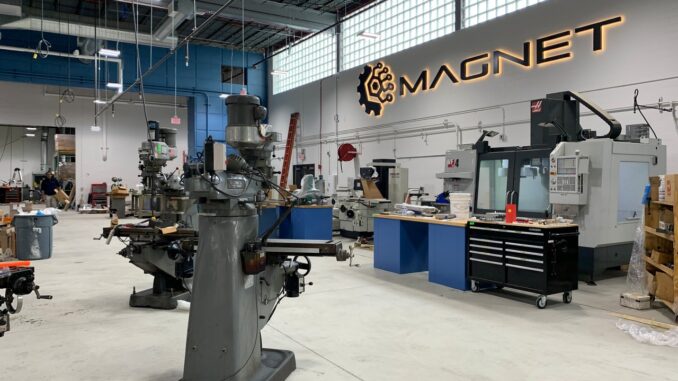
Ohio manufacturers take on their biggest challenge from the ground up
By Terry Troy
It’s a story with both an upside and downside, but the challenges and opportunities are being addressed.
Manufacturing continues to drive Ohio’s economy, being the largest of our state’s 20 economic sectors, including government. And while there have been some recent good news in terms of manufacturing in computer chips, electrical vehicles (EV) and EV batteries, there are still substantial challenges to long-term growth. However, many of those challenges are not unique to our state.
Ohio employs approximately 689,900 people in manufacturing, according to the latest statistics from the Ohio Manufacturers Association (OMA), trailing only California and Texas—states with much larger populations. As of the third quarter last year, Ohio’s manufacturing GDP was $133.16 billion, making it fourth largest in the nation, trailing only California, Texas and Illinois, according to the U.S. Bureau of Economic Analysis.

“Ohio is not just a manufacturing state, it is THE manufacturing state,” says Ryan Augsburger, president of the OMA, which represents more than 1,500 manufacturers. “If you look at the Great Lakes region, it’s where manufacturing is clustered. Ohio is going to benefit from significant investments coming from companies like Intel as well as those investing in production of EVs and EV batteries. All of these are going to be tremendous in growing our manufacturing output in the very near future.”
News of Intel’s more than $20 billion investment in the construction of two leading edge chip factories in Ohio will be a boon to not only our state’s economy, but also our national economy and national security. Honda, which has been manufacturing in Ohio for well over 40 years, also selected our state to lead its EV production and inked an accompanying joint venture to build batteries. Toward the end of last year, the DeWine-Husted administration implemented a game plan to expand our state’s EV workforce.
All of which is good news, but challenges still persist. EV production, for one, has slowed with a market that is hesitant to convert away from fossil fuels, with range anxiety and infrastructure being the chief customer concerns.
“When it comes to EVs, I take a long view,” says Ethan Karp, president and CEO of MAGNET Manufacturing Advocacy & Growth Network headquartered in Cleveland.
And while he concedes that significant investments need to be made to our state and nation’s infrastructure in order to achieve electrification on highways, “the proliferation of electric vehicles is going to happen, it’s just a question of how long it will take. In the short term, it might cause some individual companies problems, but the industry is going to change.

“We need better ways to fuel our vehicles. We need to be able to access all the different forms of energy that are out there and convert them to electricity in some way. It may happen in fits and starts, but it’s going to happen. It just might not happen in a straight line.”
While our state does have a leg up in fast growing manufacturing sectors like computer chips and EV/EV batteries, it does face some of the same challenges faced by companies nationwide. One is the emergence of new technologies to keep manufacturers competitive in the global marketplace.
“There are so many new technologies coming online all the time, it almost requires constant reinvention and reinvestment in manufacturers of all sizes,” says Karp. “Manufacturers need not only the dollars to put new technology in, but they also need to know what they need and how they are going to use it.”
Another major challenge is keeping that technology pipeline full, which often requires constant investment as well.
“Many manufacturers have been going so hard that they haven’t been putting money into innovation,” says Karp. “They are riding the wave of past innovation. But eventually somebody is going to come up with a better product, a better way of making it, or their customers are going to change.”
Yet another challenge comes from the threat of offshore competition and geopolitical turmoil; the former of which might be production subsidized by foreign competitive governments, while the latter could impact supply chain, which in turn affects production.
But the biggest challenge facing manufacturers today is a homegrown threat: a talent and workforce shortfall. Once again, our state might have a leg up on addressing the problem through the OMA.
According to a recent study from Deloitte and the Manufacturing Institute entitled “Taking Charge: Manufacturers support growth with active workforce strategies,” there could be as many as 3.8 million new employees needed in manufacturing between 2024 and 2033, and that around half of these positions (or 1.9 million) could remain unfilled if our nation’s talent conundrum is not resolved. And with higher level skills being required as manufacturers continue their journey toward Industry 4.0, a major skills gap is developing, further challenging manufacturers’ ability to fill jobs across all skill levels. (If you’re unfamiliar with Industry 4.0, please see the sidebar on page 9.)
“The No. 1 challenge facing manufacturers, according to all our surveys, is the attraction and retention of talent at all levels,” says Karp. “We are addressing that problem through a number of initiatives.”
One of which is a program called ACCESS, which reaches out to adults and retrains them for manufacturing careers, many of the prospects coming out of the criminal justice system.
“But that really is just the tip of the iceberg,” says Karp. “We also run an apprenticeship program called Early College Early Career. We have a program called Train the Trainer that also helps people find good paying manufacturing careers.
“One of the problems is that manufacturing awareness for many young people is very low,” Karp adds. “So we’re very big on awareness campaigns. The biggest impact we have is when a student sees how a manufacturing facility does its work, they usually become more interested in manufacturing as a potential career.”
It’s especially helpful when a manufacturing company opens its doors to local students. That’s one of the reasons that MAGNET created (in concert with the Great Lakes Science Center in Cleveland) a hands-on workshop at its new $20 million facility in Cleveland’s Hough neighborhood.
“It’s a place where we invite students in to see how manufacturers build things, how they make prototypes,” says Karp. “They get to play with robots or make their own custom paint colors. They experience first-hand what manufacturing is all about. We have been doing this since February and so far, more than 4,000 students have come in, usually in group tours of 20 to 30 at a time, for half day tours.”
But not all manufacturing workforce challenges can be solved with a single program.
“It has to be a portfolio of programs,” says Karp. “We also work with career tech schools, offer scholarships to career tech schools and other programs. The point is you need all these programs, by different organizations, that all have to be coordinated. They need to be aligned to get people pointed to careers that they might not have previously considered.”
Unfortunately, each geographic manufacturing region in Ohio is unique in both its employment needs as well as the local career programs and other resources that are offered. The Mahoning Valley has needs that are distinct from Canton, Lorain or Central Ohio.
“And this is why you have to acknowledge the Ohio Manufacturers’ Association for its work on sector partnerships,” says Karp. “Ryan (Augusburger) and his team got us involved in the sector partnership concept in the first place, and now we are partnering with them as well as across the state.”
According to the OMA, there are 19 different Industry Sector Partnerships (ISP) covering divergent geographics and demographics across Ohio.
“Right now, we are covering about 66 of Ohio’s 88 counties, so we are not everywhere yet,” says Augsburger.
The ISP is a concept driven by local manufacturers, but their purpose is not to fill their own employment pipeline but to singularly build out the manufacturing talent pool in a specific geography.
“So we are flowing best practices and even financial resources to these 19 ISPs to enable them to engage in programs that help recruit and make populations more aware of the opportunities in manufacturing,” says Augusburger. “Certainly, that means young people. We are always trying to do that, but we also want to attract under-represented populations like women and minorities. We are also trying to attract veterans as well as justice impacted, formerly incarcerated populations—we want to attract any population that might be under-represented in manufacturing.”
How does the ISP concept work in Ohio?
“The concept only works if a few committed manufacturers come in and say, ‘We want to own the problem of developing a talent pool for our local geography,’ and they have to bring other manufacturers in,” says Augsburger. ‘It can’t be a bunch of do-gooders, like educators, social services, economic development or people from transit or housing—those are all partners. But they can’t run one of these. It has be manufacturing led, which can be a problem because manufacturers can lose focus, especially if they get busy.”
And they have to get people interested in manufacturing, not just working for their specific company.
“That comes later,” says Augsburger.
Another problem is that each of the 19 ISPs has its own organizations, career tech schools and resources, not to mention specific area-wide employment needs.
“So there is a big degree of autonomy, which is intentional,” says Augsburger. “The old paradigm [of workforce development] was tapped out, we were just waiting for government to solve the problem.
“Workforce development is not a new problem, it is an old problem. It was never going to be solved with a top-down approach. So we abandoned it. We knew we had to do this from the bottom up. The role of government is not to supply the employer community or to own and coordinate this. The role of government is to supply the employer community where and when it is organized in a purposeful way to improve talent pipelines.”
It’s a by-your-own bootstraps approach that should help us at least address the talent shortfall that’s impacting many manufacturers nationwide.
“Better still, it should also give many more people an access to a wonderful, family sustaining career in manufacturing,” says Augsburger.
